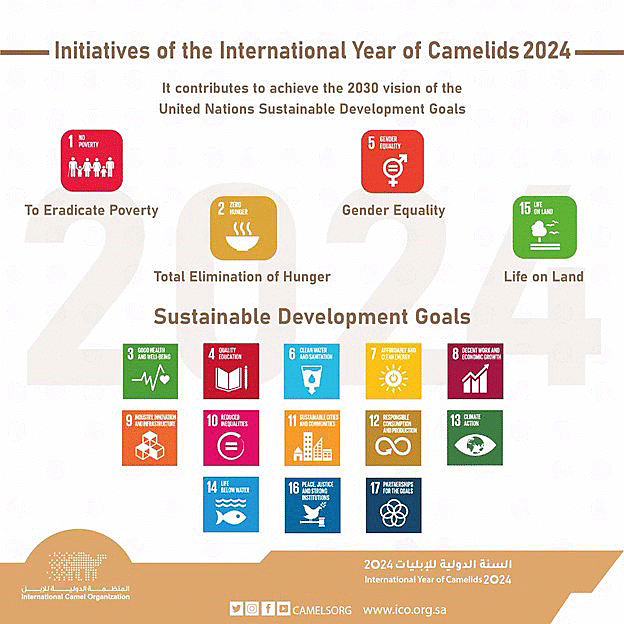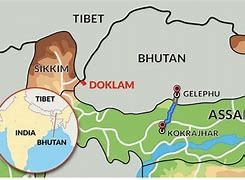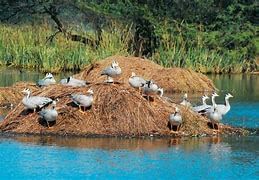UPSC Daily Current Affairs- 19th December 2023 | Current Affairs & Hindu Analysis: Daily, Weekly & Monthly PDF Download
GS-I
Yogmaya Temple
Subject: History and Culture

Why in News?
Yogmaya Temple is a historically important monument believed to be standing at the site of an ancient temple that is said to have come up during the period of the Mahabharata.
About Yogmaya Temple:
- It is also known as the Jogmaya Temple, is an ancient Hindu shrine situated in the heart of Mehrauli (Delhi), a few hundred metres away from the famous Qutub Minar.
- It was built by a noble in the court of Mughal Emperor Akbar II by the name of Lala Sidhu Mal between 1806 and 1837.
- The area was known as Yoginipura in ancient Jain texts and Prithviraj Chauhan himself was said to have patronised a Yogini temple here shortly before his city’s destruction.
- It was a focal point of Akbar II’s rule.
- The temple has a replica of the Goddess Yogmaya, also called the “Pure Goddess.
- The most famous festival celebrated only in this temple is the ‘Phoolwalon ki Sair.’
Source: Indian Express
National Geoscience Data Repository Portal
Subject: Geography
Why in News?
The Union Ministry of Mines is to launch the National Geoscience Data Repository (NGDR) Portal on 19th December 2023 in a ceremony in New Delhi.
About the National Geoscience Data Repository Portal:
- It is a comprehensive online platform for accessing, sharing, and analysing geospatial information across India.
- The NGDR initiative was spearheaded by the Geological Survey of India (GSI) and Bhaskaracharya Institute of Space Applications and Geoinformatics (BISAG-N).
- It represents a significant leap forward in democratising critical geoscience data, empowering stakeholders across industries and academia with unprecedented access to invaluable resources.
About Geological Survey of India
- The Geological Survey of India (GSI) was set up in 1851 primarily to find coal deposits for the Railways.
- Over the years, GSI has not only grown into a repository of geo-science information required in various fields in the country but has also attained the status of a geo-scientific organisation of international repute.
- Its main functions relate to creating and updating of national geoscientific information and mineral resource assessment.
- GSI’s chief role includes providing objective, impartial and up-to-date geological expertise and geoscientific information of all kinds, with a focus on policy making decisions, commercial and socio- economic needs.
- GSI also emphasises on systematic documentation of all geological processes, both surface and subsurface, of India and its offshore areas. The organisation carries out this work through geological, geophysical, & geochemical surveys using the latest and most cost-effective techniques and methodologies.
- GSI is an attached office of the Ministry of Mines.
- Headquarters: Kolkata
- It has six regional offices located in Lucknow, Jaipur, Nagpur, Hyderabad, Shillong and Kolkata and state unit offices in almost all states of the country.
Source: PIB
GS-II
2024: Celebrating the International Year of Camelids
Subject: International Relations
Why in News?
The United Nations has declared 2024 as the International Year of Camelids. This declaration aims to highlight the crucial role of Camelids in the lives of people globally.
About Camelids
- FAO’s Statement: According to the Food and Agricultural Organization (FAO), Camelids significantly impact millions of households in over 90 countries.
- Species Included: Camelids encompass alpacas, Bactrian camels, dromedaries, guanacos, llamas, and vicuñas.
- Role in Food Security and Economy: These animals contribute to food security, nutrition, and economic growth, particularly benefiting Indigenous Peoples and local communities.
Importance of Camelids
- Contribution to Sustainable Development Goals: Camelids play a vital role in achieving the Sustainable Development Goals (SDGs) set by the United Nations.
- Source of Nutrition: They provide milk and meat, essential in combating hunger.
- Fibre Production: Camelids produce fibre used for clothing and shelter.
- Transportation and Agriculture: They serve as a means of transportation and produce organic fertilizer for agriculture.
- Adaptability: Known for their ability to survive in harsh conditions, Camelids are significant in regions like the Andes and arid lands of Africa and Asia.
- Climate Change Awareness: Camelids symbolize resilience and can help raise awareness about climate change.
Goals of the International Year of Camelids 2024
- Awareness and Investment: The year aims to increase awareness of Camelids’ untapped potential and advocate for more investment in this sector.
- Advocacy for Research and Innovation: The initiative calls for enhanced research, capacity development, and the adoption of innovative practices and technologies in the Camelids sector.
Source: The Hindu
Gelephu Mega-City Project
Subject: International Relations
Why in News?
The Gelephu “mindfulness” mega-city project, announced by King Jigme Khesar Namgyel Wangchuck, is set to be a pivotal task for Bhutan’s future PM.
- This Special Administrative Region (SAR) project in the Bodoland Territorial Region (BTR) aims to address economic challenges and reverse youth migration trends.
About Gelephu Project
| Details | |
| Location |
|
| Announcement |
|
| Project Vision |
|
| Area and Structure |
|
| Economic and Social Goals |
|
| Infrastructure Development |
|
| Environmental and Cultural Focus |
|
Energy |
|
International Collaboration |
|
Geopolitical Significance |
|
| Advanced Safety Features |
|
Source: The Hindu
GS-III
TEMPO satellite
Subject: Science and Technology

Why in News?
NASA's new satellite TEMPO measures air pollution hourly has shown significant progress and now the space agency officials are already thinking about ways to extend its life.
About the TEMPO satellite:
- Tropospheric Emissions Monitoring of Pollution (TEMPO) monitors major air pollutants across North America.
- Its monitoring range extends from Canada’s oil sands to the Yucatán Peninsula and across the Atlantic to the Pacific Ocean.
- It is part of a virtual constellation with South Korea's Geostationary Environment Monitoring Spectrometer (GEMS) and the European Space Agency’s upcoming satellite, aiming for comprehensive air pollution monitoring over the Northern Hemisphere.
- It will make important scientific observations, including that of ozone, nitrogen oxide, sulphur dioxide and formaldehyde levels.
- It is capable of measuring air quality over North America hourly during the daytime with a resolution of several square miles.
- It monitors the effects of everything from rush-hour traffic to pollution from forest fires and volcanoes.
- The present pollution-monitoring satellites are in low Earth orbit (LEO), but this new monitoring instrument is hosted in geostationary orbit.
- It was designed for a 20-month operation.
Source: Hindustan Times
Sultanpur National Park
Subject: Environment and Ecology

Why in News?
According to forest department officials the Sultanpur National Park in Farrukh Nagar, Gurugram has reported a decrease of 20-30 per cent in the number of migratory birds this season.
About Sultanpur National Park:
- Sultanpur National Park, formerly known as Sultanpur Bird Sanctuary, is located in the Gurgaon district in Haryana. It comprises mainly wetlands.
- This national park is a major habitat for aquatic birds, including migratory and resident birds.
- It was notified as a Ramsar site, a wetland of international importance, in 2021.
- Vegetation: Tropical and dry deciduous. It also features seasonal aquatic vegetation and is dotted with artificial islands; the Park also includes open grasslands.
- Flora: Grasses, dhok, khair, tendu, ber, jamun, banyan tree and neem etc.
- Fauna:
- It is a very important wintering ground for waterfowl.
- Some of the resident and migratory species of birds found in the area are the Common hoopoe, Purple sunbird, Black francolin, Little cormorant, Indian Cormorant, Siberian Crane, Greater Flamingo, Common Teal, Common Greenshank, Ruff, etc.
Source: Indian Express
Telecommunications Bill, 2023: Emphasizing National Security and Regulatory Framework
Subject: Economy

Why in News?
The Telecommunications Bill, 2023, was introduced in the Lok Sabha focusing on the development and regulation of telecommunication services and networks.
- The Bill aims to consolidate existing laws and adapt to the evolving nature of telecommunications, emphasizing national security and inclusive digital growth.
Telecommunications Bill, 2023
- Replaces Existing Acts: The Bill seeks to replace the Indian Telegraph Act, 1885, the Indian Wireless Telegraphy Act, 1933, and the Telegraph Wires (Unlawful Possession) Act, 1950.
- Focus on Modernization: Recognizing the significant changes in telecommunication technologies and usage, the Bill proposes a contemporary legal framework for the sector.
National Security Provisions in the Telecom Bill
- Government Control in Emergencies: The Bill allows the government to temporarily take control of telecom services during public emergencies or for public safety.
- Interception and Priority Routing: It provides mechanisms for intercepting messages or routing specific messages on priority in the interest of national security, public order, and other key areas.
- Press Message Regulations: The Bill stipulates conditions under which press messages may be intercepted, detained, or prohibited from transmission.
- Government Directives for Message Transmission: The government can direct telecom services to transmit specific messages in the public interest.
Implications and Significance
- Enhanced Security Measures: The Bill’s provisions for government intervention in telecom services during emergencies highlight a focus on national security and public safety.
- Balancing Security and Freedom: While ensuring security, the Bill also acknowledges the need to safeguard press freedom, with specific rules for accredited correspondents.
- Modern Regulatory Framework: By replacing outdated laws, the Bill aims to create a regulatory environment that aligns with current technological advancements and societal needs.
Conclusion
- Adapting to Changing Dynamics: The Telecommunications Bill, 2023, represents a significant step in updating India’s legal framework for telecommunications, keeping pace with global technological trends.
- Focus on National Security: The emphasis on national security and public safety within the Bill reflects the government’s commitment to ensuring a secure and resilient telecommunications infrastructure.
Source: The Hindu
|
38 videos|5258 docs|1111 tests
|
















